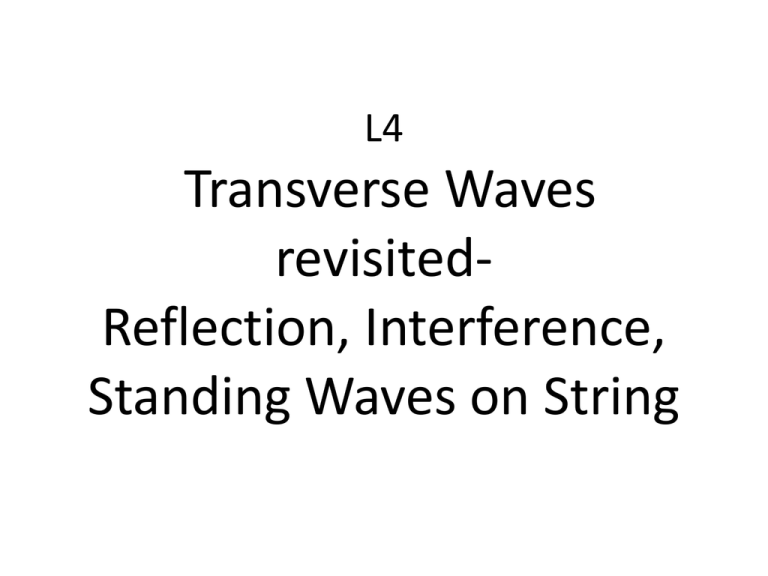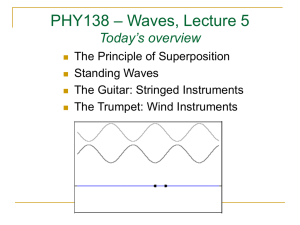Transverse Waves revisited- Reflection, Interference, Standing
advertisement

L4 Transverse Waves revisitedReflection, Interference, Standing Waves on String Transverse wave propagation Wave reflection at a fixed end: the restoring force in the boundary material causes an upward pulse to become a downward pulse upon reflection Wave reflection at an open end: the upward pulse maintains its orientation upon reflection PhET Simulation Wave on a String Wave Interference/ Wave Superposition Ct 4.5.2.sup The pulse on the left is moving right, the pulse on the right is moving left. What do you see at the "central moment" they pass through one another? Ct 4.5.2.sup A B D C E SIM www.physics.nyu.edu/~ts2/Animation/waves.html Suppose the pulse reflected from a boundary and moving to the left seen earlier meets another pulse moving to the right… Identical waves moving in opposite directions Motion of point along the spring Understanding Reflection using Superposition The physics of waves is local – each spot in the medium (i.e. the rope) is only influenced by the spots next to it This means that a fixed rope obeys the same physics as an infinite rope, with one exception: the point at the end, a.k.a. the boundary If we take a pulse on an infinite rope, and add an inverted mirror image of the pulse travelling in the other direction, it is guaranteed to interfere destructively so that the center point does not move. If the center does not move, the left side looks exactly as if it had reflected off a fixed boundary This way of thinking about reflection is the method of images Boundary for free end Slope = difference in tension = one part of rope pulling on the other At end, there’s nothing to pull on, so rope must be flat To make this using images, we think of a mirrorimage pulse that’s not inverted Wave reflection simulation: http://www.walterfendt.de/ph14e/stwaverefl.htm Reflection off of two boundaries • It’s like looking at yourself in two mirrors – you must use infinite images! • If you try to fit in a wave with the wrong wavelength, all the infinite images have destructive interference and give zero – only waves with nodes at the walls work! Standing wave Applet http://webphysics.davidson.edu/A pplets/superposition/default.html (Example 2) Standing wave representation Standing Waves in a Stretched String Conditions for standing waves Recall that f=v/λ Hence fn =n f1 where f1 = v/(2L) f1 is called the fundamental frequency (the lowest possible frequency) All harmonics (n= 1,2,3,…) are possible excitations for a string held at both ends! f2 is called the 2nd harmonic, and is also sometimes referred to as st the 1 overtone (especially in reference to sound). f3 is the 3d harmonic or the 2nd overtone, etc. Recall that v=f λ. Suppose we keep v and the length of the string constant. Can we establish a standing wave if we increase the vibrating frequency from f1 to 1.2 f1? A) yes B) no C) sometimes D) Not enough information given Standing Waves on a String (rope) Demo




